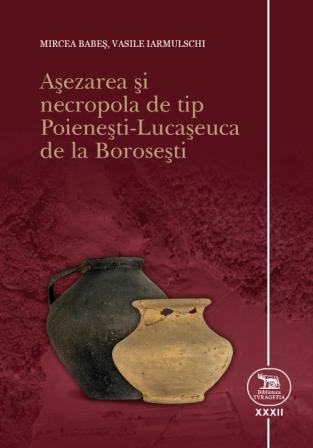Durch die Menge und den besonderen Wert der wissenschaftlichen Informationen, erweist sich der archäologische Fundplatz von Borosești (Landkreis Iași, Gemeinde Scânteia) als äußerst bedeutsam, um wichtige Probleme in Bezug auf die kulturhistorischen Zusammenhänge ab dem Ende des 1. Jhds. v. Chr. im ostkarpatischen Raum zu erkennen und aufzuklären.
In den Jahren 1968-1978 (mit kleinen Unterbrechungen) wurden die Siedlung und die Nekropole von Borosești von M. Babeș erforscht. Während drei Ausgrabungskampagnen (1968, 1970 und 1972) in der Siedlung, wurden vier Schnitte und sechs Kassetten erstellt. Dabei wurden die Überreste von drei (?) oberflächigen Bebauungen, sieben Gruben, sowie umfangreiches archäologisches Material freigelegt, die der Poienești-Lucașeuca-Kultur zugeschrieben werden.
Der Nekropole wurde mehr Aufmerksamkeit als der Siedlung zu Teil und in mehreren Ausgrabungen umfangreich erforscht. Während sechs archäologischer Kampagnen (1972-1974, 1976-1978) wurde eine Fläche von 2550 Quadratmetern untersucht und dabei die gesamte Nekropole (150 Gräber) freigelegt. In Boroseşti können zwei Arten von Gräbern unterschieden werden: Von den insgesamt 150 entdeckten Bestattungen sind 136 (90,66%) Urnengräber und 14 (9,34%) Grubengräber.
Die relative Chronologie von Borosești basiert hauptsächlich auf der Analyse der Entdeckungen auf dem Gräberfeld. In Anbetracht der Kombinationen von Inventarstücken wurden zwei Hauptgruppen von Gräbern unterschieden, die unserer Meinung nach zwei Bestattungsphasen entsprechen. Diese Etappen können mit den Phasen C2-D1 der Latène-Kultur in Mitteleuropa oder mit der ersten und zweiten Phase der jüngeren vorrömischen Eisenzeit nach R. Hachmann synchronisiert werden, die in absoluter Chronologie dem zweiten Viertel des 2. bis zur ersten Hälfte des 1. Jhd. v. Chr. entspricht.
In Bezug auf den Ursprung der Funde aus Borosești ist zu erwähnen, dass für die meisten von ihnen Analogien in Mitteleuropa zu finden sind. Das lässt vermuten, dass ab der zweiten Hälfte des 3. Jhd. v. Chr. die Bevölkerungsgruppen aus verschiedenen Regionen des Jastorf-Raums, insbesondere aus dem Elbe-Oder Gebiet, in mindestens drei archäologisch nachvollziehbaren Migrationsphasen nach Südosten gezogen sind und sich in der Karpaten-Dnjestrischen Waldsteppe niedergelassen haben. Die angestammte Bevölkerung, die in diesem Raum unterschiedliche Namen trugen, verloren im Zuge der Migration ihre alte Stammesidentität. Sie gruppierten sich in die neuen Gemeinschaften ein und wurden der griechischen und römischen Welt unter dem Gattungsnamen Bastarnen bekannt.
INHALTVERZEICHNIS
EINLEITUNG
I. DIE SIEDLUNG BEIM BOROSEȘTI
I.1. Umfang der Grabung
I.2. Stratigraphie
I.3. Beschreibung den Befunden der P-L-Kultur
I.4. Hütten und andere Befunde
II. DIE NEKROPOLE BEIM BOROSEȘTI
II.1. Fundkatalog
II.1.1. Gräber
II.1.2. Ritualische Gruben
II.1.3.Funde entdeckte passim
II.2. Bestattungssitten
II.3. Bestattungsrituale
II.4. Untersuchung der Ausstattungkombinationen
III FUNDMATERIAL
III.1. Keramik
III.1.1. Handgemachte Keramik
III.1.2. Drehscheibenkeramik
III.2. Eisen- und Holzbehälter
III.3. Werkzeuge und Geräte
III.3.1. Tongegenstände
III.3.2. Steingeräte
III.3.3. Gegenstände aus Metall
III.4. Kultgegenstände
III.5. Trachtgegenstände
III.6. Toilettengegenstände
III.7. Schmuckgegenstände
III.8. Waffen und Ausrüstungsgegenstände
IV CHRONOLOGIE
IV.1. Chronologie der Siedlung und der Nekropole
IV.2. Chronologische Beziehungen zur Chronologie der P-L-Kultur
IV.3. Chronologische Beziehungen zur Latène-Kultur
IV.4. Chronologische Beziehungen zu den „germanischen" Kulturen
IV.5. Die absolute Chronologie der Siedlung und der Nekropole
SCHLUSSFOLGERUNGEN
LITERATUR
Liste der Abbildungen und Tafeln




















































